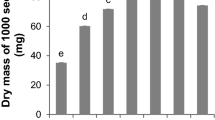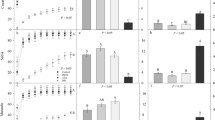Abstract
Seed deterioration is detrimental to plant germplasm conservation, and predicting seed germination and vigor with reliability and sensitivity means is urgently needed for practical problems. We investigated the link between hydrogen peroxide (H2O2) flux, oxygen influx and seed vigor of Caragana korshinskii by the non-invasive micro-test technique (NMT). Some related physiological and biochemical changes in seeds were also determined to further explain the changes in the molecular fluxes. The results showed that there was a good linear relationship between germination and H2O2 flux, and that O2 influx was more suitable for assessing seed vigor. H2O2 flux changed relatively little initially, mainly affected by antioxidants (APX, CAT and GSH) and H2O2 content; afterward, the efflux increased more and more rapidly due to high membrane permeability. With the damage of mitochondrial respiration and membrane integrity, O2 influx was gradually reduced. We propose that monitoring H2O2 and O2 fluxes by NMT may be a reliable and sensitive method to evaluate seed germination and vigor.







Similar content being viewed by others
Abbreviations
- ADP/O:
-
Phosphate oxygen ratio
- APX:
-
Ascorbate peroxidase
- CAT:
-
Catalase
- GSH:
-
Reduced glutathione
- GSSG:
-
Oxidized glutathione
- IM:
-
Inner membrane
- NMT:
-
Non-invasive micro-test technique
- OM:
-
Outer membrane
- RCR:
-
Relative electric conductivity
- ROS:
-
Reactive oxygen species
References
Amable RA, Obendorf RL (1986) Soybean seed respiration during simulated preharvest deterioration. J Exp Bot 37:1364–1375
Andreyev AY, Kushnareva YE, Starkov AA (2005) Mitochondrial metabolism of reactive oxygen species. Biochemistry (Moscow) 70:200–214
Apel K, Hirt H (2004) Reactive oxygen species: metabolism, oxidative stress, and signal transduction. Annu Rev Plant Biol 55:373–399
Benamar A, Tallon C, Macherel D (2003) Membrane integrity and oxidative properties of mitochondria isolated from imbibing pea seeds after priming or accelerated ageing. Seed Sci Res 13:35–45
Bernal-Lugo I, Leopold AC (1998) The dynamics of seed mortality. J Exp Bot 49:1455–1461
Bettey M, Finch-Savage WE (1996) Respiratory enzyme activities during germination in Brassica seed lots of differing vigour. Seed Sci Res 6:165–174
Bhattacharjee S (2005) Reactive oxygen species and oxidative burst: roles in stress, senescence and signal. Curr Sci India 89:1113–1121
Borisjuk L, Rolletschek H (2009) The oxygen status of the developing seed. New Phytol 182:17–30
Braga RA, Dal Fabbro IM, Borem FM, Rabelo G, Arizaga R, Rabal HJ, Trivi M (2003) Assessment of seed viability by laser speckle techniques. Biosyst Eng 86:287–294
Cadenas E, Davies KJ (2000) Mitochondrial free radical generation, oxidative stress, and aging. Free Radic Bio Med 29:222–230
Chaturvedi P, Taguchi M, Burrs SL, Hauser BA, Salim W, Claussen JC, McLamore ES (2013) Emerging technologies for non-invasive quantification of physiological oxygen transport in plants. Planta 238:599–614
Chojnowski M, Corbineau F, Côme D (1997) Physiological and biochemical changes induced in sunflower seeds by osmopriming and subsequent drying, storage and aging. Seed Sci Res 7:323–332
Copeland LO, McDonald MB (2001) Seed vigor and vigor tests. In: Copeland LO, McDonald MB (eds) Principles of seed science and technology, 4th edn. Kluwer, pp 121–144
Freitas RA, Dias DCFS, Oliveira MGA, Dias LAS, Jose IC (2006) Physiological and biochemical changes in naturally and artificially aged cotton seeds. Seed Sci Technol 34:253–264
Generozova IP, Maevskaya SN, Shugaev AG (2009) The inhibition of mitochondrial metabolic activity in etiolated pea seedlings under water stress. Russ J Plant Physiol 56:38–44
Goel A, Goel AK, Sheoran IS (2003) Changes in oxidative stress enzymes during artificial ageing in cotton (Gossypium hirsutum L.) seeds. J Plant Physiol 160:1093–1100
Hu D, Ma G, Wang Q, Yao J, Wang Y, Pritchard HW, Wang X (2012) Spatial and temporal nature of reactive oxygen species production and programmed cell death in elm (Ulmus pumila L.) seeds during controlled deterioration. Plant Cell Environ 35:2045–2059
ISTA (2009) International rules for seed testing. International Seed Testing Association, Bassersdorf, Switzerland
Kerchev PI, Fenton B, Foyer CH, Hancock RD (2012) Plant responses to insect herbivory: interactions between photosynthesis, reactive oxygen species and hormonal signalling pathways. Plant Cell Environ 35:441–453
Kranner I, Birtić S, Anderson KM, Pritchard HW (2006) Glutathione half-cell reduction potential: a universal stress marker and modulator of programmed cell death? Free Radic Bio Med 40:2155–2165
Kranner I, Kastberger G, Hartbauer M, Pritchard HW (2010) Noninvasive diagnosis of seed viability using infrared thermography. Proc Natl Acad Sci USA 107:3912–3917
Kumar S, Radhamani J, Srinivasan KA, In EKNE (2011) Physiological and biochemical changes in seeds of karanj (Pongamia pinnata) under different storage conditions. Indian J Agric Sci 81:423–428
Logan DC, Millar AH, Sweetlove LJ, Hill SA, Leaver CJ (2001) Mitochondrial biogenesis during germination in maize embryos. Plant Physiol 125:662–672
McDonald MB (1999) Seed deterioration: physiology, repair and assessment. Seed Sci Technol 27:177–237
McLamore ES, Jaroch D, Chatni MR, Porterfield DM (2010a) Self-referencing optrodes for measuring spatially resolved, real-time metabolic oxygen flux in plant systems. Planta 232:1087–1099
McLamore ES, Zhang W, Porterfield DM, Banks MK (2010b) Membrane-aerated biofilm proton and oxygen flux during chemical toxin exposure. Environ Sci Technol 44:7050–7057
Mittler R (2002) Oxidative stress, antioxidants and stress tolerance. Trends Plant Sci 7:405–410
Møller IM (2001) Plant mitochondria and oxidative stress: electron transport, NADPH turnover, and metabolism of reactive oxygen species. Annu Rev Plant Biol 52:561–591
Møller IM, Jensen PE, Hansson A (2007) Oxidative modifications to cellular components in plants. Annu Rev Plant Biol 58:459–481
Navrot N, Rouhier N, Gelhaye E, Jacquot JP (2007) Reactive oxygen species generation and antioxidant systems in plant mitochondria. Physiol Plant 129:185–195
Neill SJ, Desikan R, Clarke A, Hurst RD, Hancock JT (2002) H2O2 and nitric oxide as signalling molecules in plants. J Exp Bot 53:1237–1247
Parys E, Jastrzębski H (2008) Mitochondria from leaf mesophyll cells of C4 plants are deficient in the H protein of glycine decarboxylase complex. J Plant Physiol 165:1061–1069
Perez MA, Argüello JA (1995) Deterioration in peanut (Arachis hypogaea L. cv. Florman) seeds under natural and accelerated aging. Seed Sci Technol 23:439–445
Quan LJ, Zhang B, Shi WW, Li HY (2008) H2O2 in plants: a versatile molecule of the reactive oxygen species network. J Integr Plant Biol 50:2–18
Sanchez BC, Ochoa-Acuña H, Porterfield DM, Sepúlveda MS (2008) Oxygen flux as an indicator of physiological stress in fathead minnow (Pimephales promelas) embryos: a real-time biomonitoring system of water quality. Environ Sci Technol 42:7010–7017
Seal CE, Zammit R, Scott P, Nyamongo DO, Daws MI, Kranner I (2010) Glutathione half-cell reduction potential as a seed viability marker of the potential oilseed crop Vernonia galamensis. Ind Crop Prod 32:687–691
Smith MM, Hodson MJ, Öpik H, Wainwright SJ (1982) Salt-induced ultrastructural damage to mitochondria in root tips of a salt-sensitive ecotype of Agrostis stolonifera. J Exp Bot 33:886–895
Song S, Fredlund KM, Moller LM (2001) Changes in low-molecular weight heat shock protein 22 of mitochondria during high-temperature accelerated ageing of Beta vulgaris L.seeds. Acta Phytophysiol Sin 27:73–80
Steffens B, Steffen-Heins A, Sauter M (2013) Reactive oxygen species mediate growth and death in submerged plants. Front plant Sci 4:1–7
Stupnikova I, Benamar A, Tolleter D, Grelet J, Borovskii G, Dorne AJ, Macherel D (2006) Pea seed mitochondria are endowed with a remarkable tolerance to extreme physiological temperatures. Plant Physiol 140:326–335
Tanou G, Job C, Rajjou L, Arc E, Belghazi M, Diamantidis G, Molassiotis A, Job D (2009) Proteomics reveals the overlapping roles of H2O2 and nitric oxide in the acclimation of citrus plants to salinity. Plant J 60:795–804
Taylor NL, Tan Y, Jacoby RP, Millar AH (2009) Abiotic environmental stress induced changes in the Arabidopsis thaliana chloroplast, mitochondria and peroxisome proteomes. J Proteomics 72:367–378
Van Asbrouck J, Taridno P (2009) Using the single seed oxygen consumption measurement as a method of determination of different seed quality parameters for commercial tomato seed samples. Asian J Food Agro Ind S88–S95 (special issue)
Vandenabeele S, Vanderauwera S, Vuylsteke M, Rombauts S, Langebartels C, Seidlitz HK, Zabeau M, Van Montagu M, Inze D, Van Breusegem F (2004) Catalase deficiency drastically affects gene expression induced by high light in Arabidopsis thaliana. Plant J 39:45–58
Walters C, Ballesteros D, Vertucci VA (2010) Structural mechanics of seed deterioration: standing the test of time. Plant Sci 179:565–573
Wan YL, McLamore ES, Fan L, Hao H, Porterfield DM, Zhang Z, Wang W, Xu JY, Lin J (2011) Non-invasive measurement of real-time oxygen flux in plant systems with a self-referencing optrode. Protoc Exch. doi:10.1038/protex.2011.266
Wang P, Du Y, Li Y, Ren D, Song C (2010) H2O2–mediated activation of MAP Kinase 6 modulates nitric oxide biosynthesis and signal transduction in Arabidopsis. Plant Cell 22:2981–2998
Wang WQ, Cheng HY, Møller IM, Song SQ (2012) The role of recovery of mitochondrial structure and function in desiccation tolerance of pea seeds. Physiol Plant 144:20–34
Xin X, Wan YL, Wang WJ, Yin GK, McLamore ES, Lu XX (2013) A real-time, non-invasive, micro-optrode technique for detecting seed viability by using oxygen influx. Sci Rep 3:3057
Xu Y, Sun T, Yin L (2006) Application of non-invasive microsensing system to simultaneously measure both H+ and O2 fluxes around the pollen tube. J Integr Plant Biol 48:823–831
Yamamoto Y, Kobayashi Y, Devi SR, Rikiishi S, Matsumoto H (2002) Aluminum toxicity is associated with mitochondrial dysfunction and the production of reactive oxygen species in plant cells. Plant Physiol 128:63–72
Yin G, Sun H, Xin X, Qin G, Liang Z, Jing X (2009) Mitochondrial damage in the soybean seed axis during imbibition at chilling temperatures. Plant Cell Physiol 50:1305–1318
Zhang M, Zhuo JJ, Wang X, Wu S, Wang XF (2010) Optimizing seed water content: relevance to storage stability and molecular mobility. J Integr Plant Biol 52:324–331
Zorov DB, Juhaszova M, Sollott SJ (2006) Mitochondrial ROS-induced ROS release: an update and review. BBA Bioenerg 1757:509–517
Acknowledgments
This work was supported by National Forest Department 948 Project (Grant No. 2011-4-54) and National Forestry Public Welfare Industry Scientific Research Project (Grant No. 201104024). We thank all researchers for their loyal help during the study. We also thank Xuyue (Beijing) Sci.&Tech.Co., Ltd. for their technical supports, and we declare that the authors have no conflict of interest.
Author information
Authors and Affiliations
Corresponding author
Rights and permissions
About this article
Cite this article
Li, J., Wang, Y., Pritchard, H.W. et al. The fluxes of H2O2 and O2 can be used to evaluate seed germination and vigor of Caragana korshinskii . Planta 239, 1363–1373 (2014). https://doi.org/10.1007/s00425-014-2049-7
Received:
Accepted:
Published:
Issue Date:
DOI: https://doi.org/10.1007/s00425-014-2049-7




